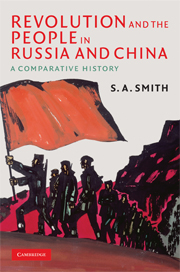Book contents
- Frontmatter
- Contents
- Acknowledgments
- Introduction: Capitalist Modernity and Communist Revolution
- 1 Memories of Home: Native-place Identity in the City
- 2 The Awakening Self: Individuality and Class Consciousness
- 3 After Patriarchy: Gender Identities in the City
- 4 Saving the Nation: National and Class Identities in the City
- 5 Workers and Communist Revolution
- Index
- References
4 - Saving the Nation: National and Class Identities in the City
Published online by Cambridge University Press: 05 June 2012
- Frontmatter
- Contents
- Acknowledgments
- Introduction: Capitalist Modernity and Communist Revolution
- 1 Memories of Home: Native-place Identity in the City
- 2 The Awakening Self: Individuality and Class Consciousness
- 3 After Patriarchy: Gender Identities in the City
- 4 Saving the Nation: National and Class Identities in the City
- 5 Workers and Communist Revolution
- Index
- References
Summary
This chapter explores the interrelationship of class and national identities in two ailing dynastic empires struggling to become modern nation states. A central element in the crisis of the anciens régimes in Russia and China was that imperial structures of government were steadily pressed to breaking point by external forces, i.e. economically powerful and militarily expansionist foreign states, and by internal forces, i.e. by political movements demanding that the dynastic state become representative of an ethnically defined people. These external and internal pressures combined to push both governments in the direction of emulating the institutions and practices of the nation state as exemplified by the western powers, in the belief that this path alone promised salvation in a modern world of competing nationalisms.
Until the second half of the nineteenth century, the Russian Empire was held together by an autocratic regime that cooperated relatively comfortably with the non-Russian nobilities on its peripheries and tolerated non-Russian cultures and religions. Only with the rise of nationalism and the increasing systematization of administration did the privileges of regional elites, such as those of Poles, Baltic Germans and Finlanders, come under attack, at roughly the same time as the tsarist government launched its project of colonization in Central Asia and the Caucasus.
The Qings, too, proved capable of accommodating local particularities, ruling their empire – of which China was notionally only one part – in what Pamela Crossley calls ‘multiple frames’ (hebi).
- Type
- Chapter
- Information
- Revolution and the People in Russia and ChinaA Comparative History, pp. 151 - 191Publisher: Cambridge University PressPrint publication year: 2008



